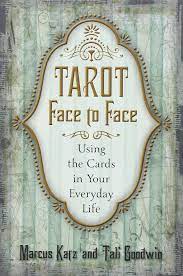by Marcus Katz and Tali Goodwin

Tarot Face to Face is a book whose title is slightly misleading — I found that instead of “Using cards in your everyday life,” this book is geared towards tarot readers getting ready to make the jump to reading professionally. This makes it a valuable addition to your library, especially if you are starting out reading professionally, or contemplating it as an option later on.
I appreciate that this book provides some tarot basics, but it’s more of an overview. This book assumes a level of proficiency in tarot that makes it something of a rarity. Many modern tarot books suffer from “page bloat”, using 40-80 pages just to walk readers through every card in the deck. You’ll find none of that here. There are 5 pages of tarot basics, and then delves into the real meat of the book, using spreads, reading intuitively, reading narratively, and exercises for expanding your practice and discovering your own unique reading style. It explores everything from the Kabbalah approach and astrology-based readings to neat spins on love readings (which many readers either love or hate.) These approaches are less spreads and more “This is how to read in this manner, using your personal reading style.”
There’s a dedicated section called “Elevator Tarot” that provides boilerplate/scripted responses to some of the most common questions, concerns, or objections people have to tarot, which can really help a new professional reader from being ambushed by the “Gotcha Guys” who hate tarot, but sure seem to love hanging out near the tarot readers to try and trap them in their own words. This section also includes clear guidance on maintaining your facial composure during a reading (the tarot version of a poker face) so that your clients feel at ease.
Likewise, the book addresses how to identify different types of people and their concerns, with guidance on how to alleviate fears or clarify expectations. This includes professional composure, effectively communicating your knowledge/experience, making a first impression, and props, regalia, rituals, and other elements of a professional reading.
There’s also significant page space devoted to the legal aspects of professional tarot reading, including the disclaimers and disclosures you should have to avoid liability, as well as basic business and marketing information. There’s a rich appendix of online resources and endnotes, as well as an extensive bibliography, so readers can add to their knowledge.
As a former stylist, I really appreciated this book because while there are many books out there that teach you how to read tarot, there are very few that teach you how to push your creative limits as a reader, and how to create a professional space for your clients. It’s business and marketing education for a discipline that has no real template (outside of stereotypes.) Truly a gem if you want to push yourself, refine or expand your reading style, and shake things up. But even more importantly, it is the type of professional business marketing information that can create a better professional experience for both you and your readers.